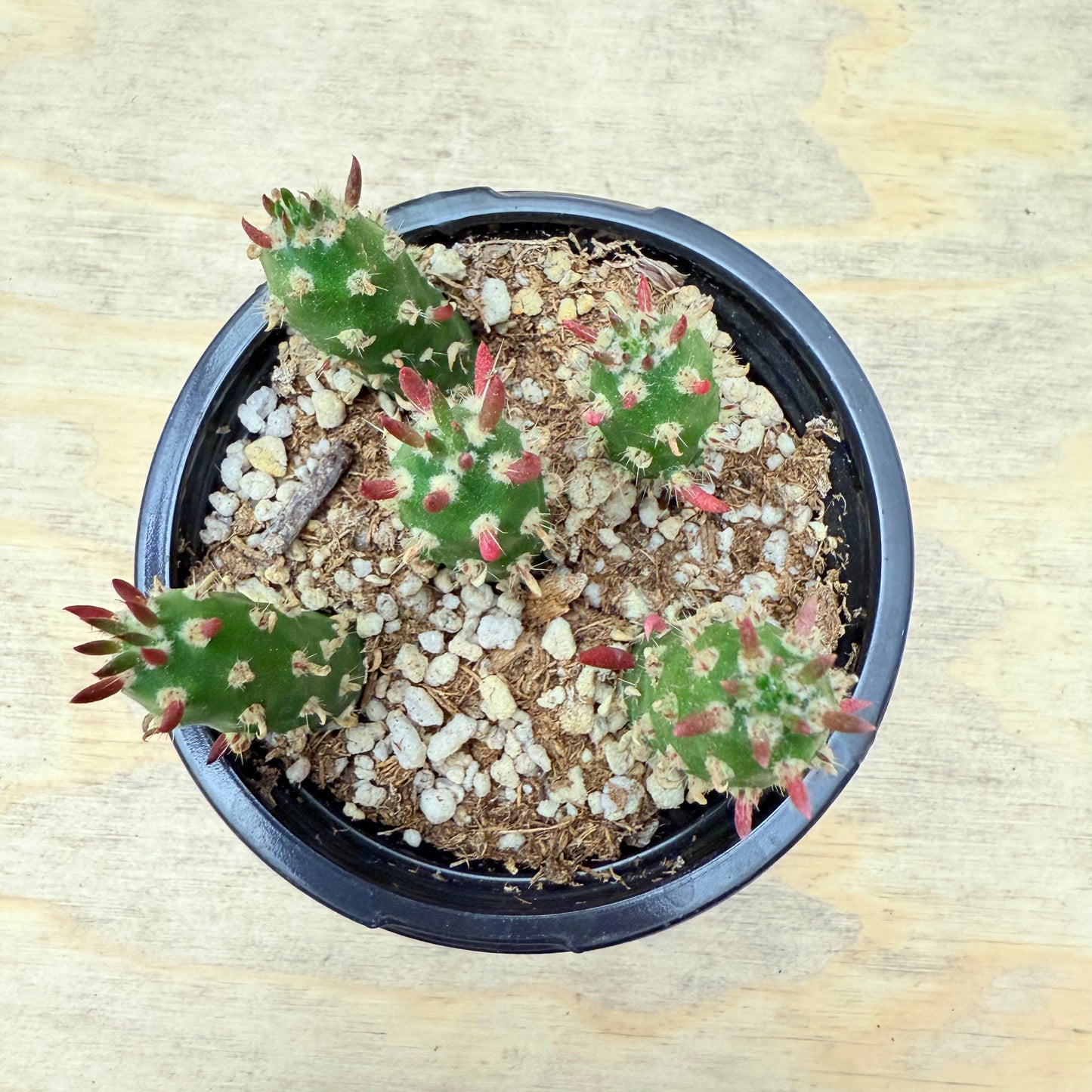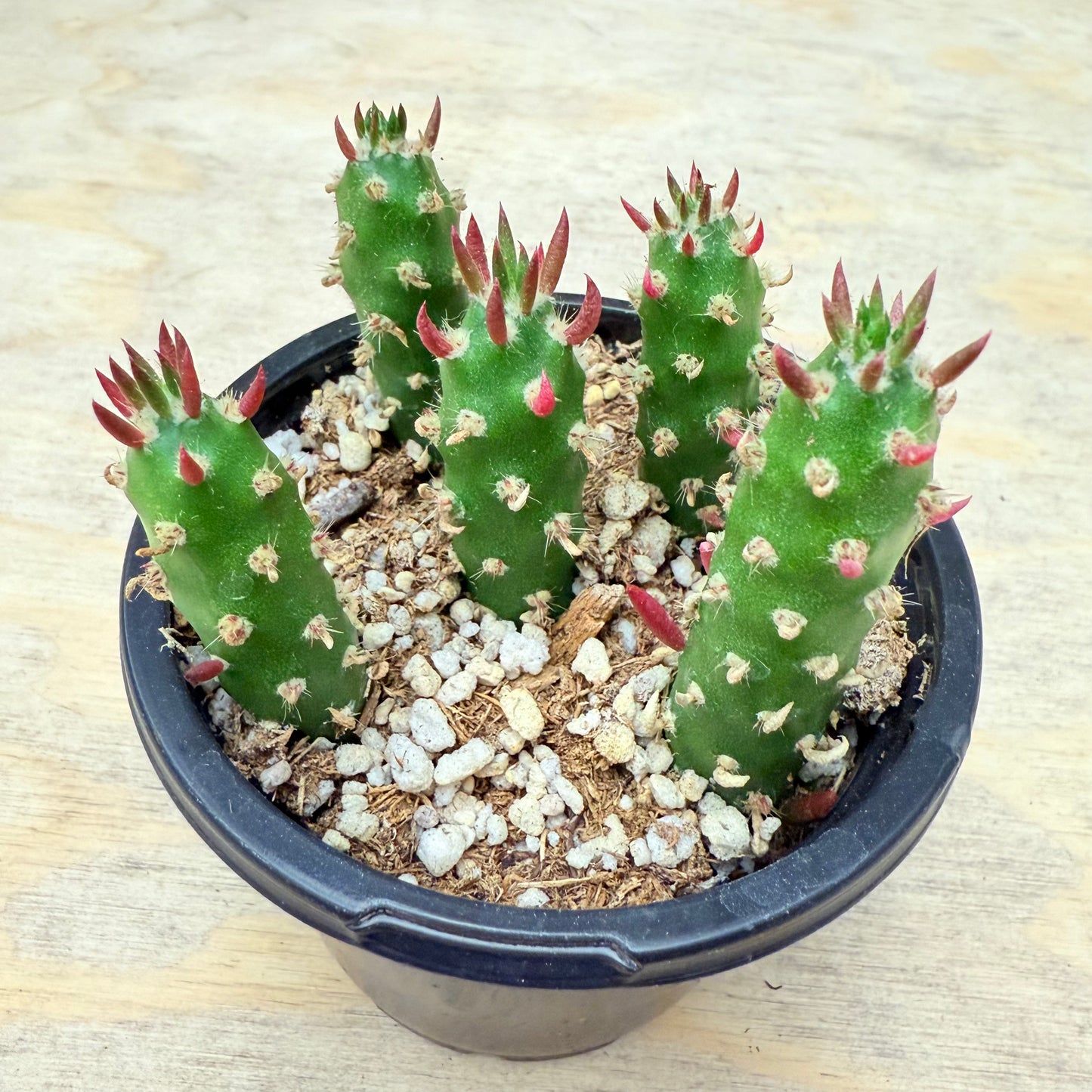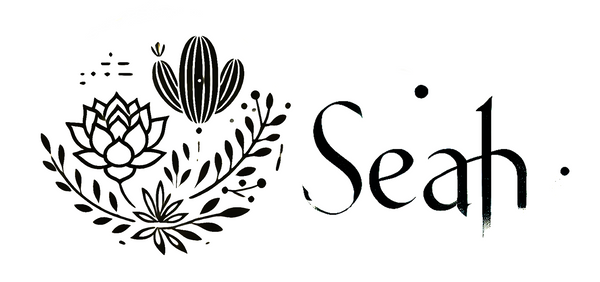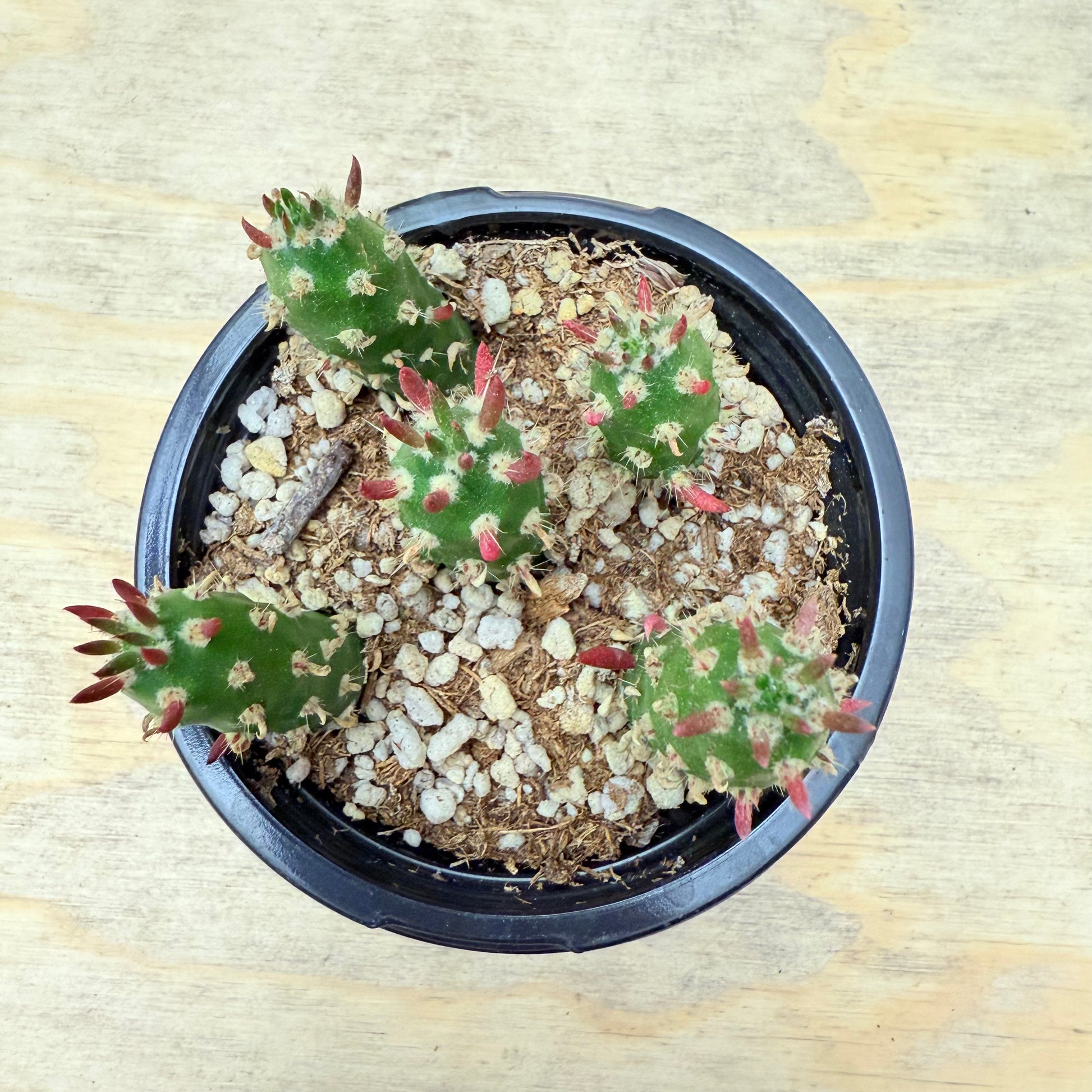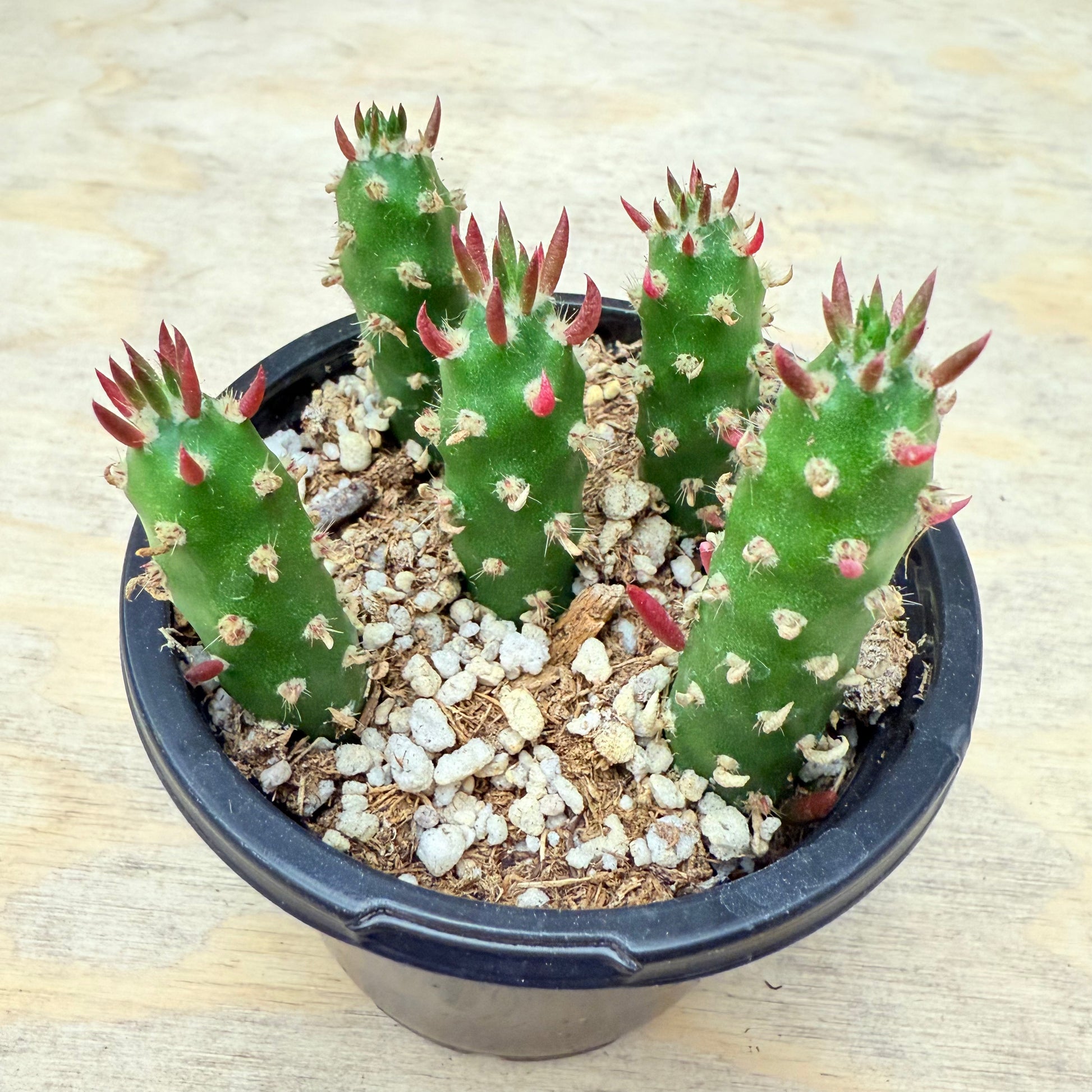Austrocylindropuntia subulata - Eve's Needle
Austrocylindropuntia subulata - Eve's Needle
In stock
Couldn't load pickup availability
📝 Description
Morphological Characteristics
Austrocylindropuntia subulata, commonly known as Eve’s Needle, is a distinctive and fast-growing cactus in the Cactaceae family, native to the Andes mountains of Peru and Ecuador. It is well known for its elongated cylindrical stems and unique awl-shaped (subulate) leaves, which is uncommon among cacti.
The plant features upright, branching stems that can grow up to 2–4 meters (6–13 feet) tall in the ground, though it stays much smaller in containers. The stems are segmented, medium green, and covered with areoles that bear short spines and, unusually for a cactus, fleshy green leaves that are 2–5 cm (0.8–2 inches) long. These narrow, pointed leaves resemble needles, giving rise to the common name “Eve’s Needle.”
As the plant matures, it may produce large, showy, tubular flowers in shades of pink or red, usually blooming from the top or tips of the stems during the warmer months. However, flowering is less common in container-grown specimens.
Growth Habits
Eve’s Needle is a vigorous, upright grower, especially when planted in the ground in warm climates. It forms multi-branched shrubs or small tree-like shapes over time. When grown in pots, it can be pruned to maintain a compact, sculptural form. It’s well-suited for outdoor xeriscaping, large succulent containers, or as a striking vertical accent in cactus gardens.
Maintenance Points
• Lighting: Prefers full sun for best growth and spine development. Indoors, place near a south-facing window with at least 6 hours of direct light.
• Watering: Water thoroughly but infrequently. Allow the soil to dry out completely between waterings. During winter, reduce watering to a minimum.
• Soil: Requires a well-draining cactus mix. Amend with coarse sand, pumice, or perlite to ensure roots don’t stay wet.
• Temperature: Thrives in warm temperatures (20–30°C / 68–86°F). Can tolerate short periods down to -2°C (28°F) if kept dry, but prolonged frost should be avoided.
• Fertilization: Apply a diluted cactus fertilizer once a month during the active growing season (spring and summer). Avoid feeding in winter.
• Potting: Use a sturdy container with drainage. Repot every 2–3 years or when root-bound. Repotting is best done in spring.
• Humidity: Prefers low humidity and good airflow. Do not mist.
Reproduction Method
1. Stem Cuttings (most common):
• Cutting: Take a healthy stem segment (at least 10–15 cm / 4–6 inches) using a sterile knife.
• Callusing: Allow the cutting to dry and callus in a shaded area for 5–10 days.
• Planting: Insert the callused end into well-draining soil. Water lightly after a few days.
• Rooting: Place in a bright, warm location. Roots typically develop within a few weeks.
2. Seeds:
• Sowing: Sow fresh seeds on a well-draining cactus seed mix.
• Germination: Maintain warm temperatures (20–25°C / 68–77°F) and moderate moisture. Germination may take 1–3 weeks.
• Transplanting: Once seedlings are large enough to handle, transplant to individual pots.
Additional Tips
• Pest Control: Watch for mealybugs, scale, and spider mites, especially on new growth. Treat promptly with neem oil or insecticidal soap.
• Disease Prevention: Avoid overwatering and ensure proper drainage to prevent stem or root rot.
• Pruning: Can be pruned to control height or remove damaged branches. Use clean tools and allow cut surfaces to callus.
• Display: Excellent in rock gardens, desert-themed landscapes, or tall succulent arrangements for dramatic vertical interest.
• Safety Note: Spines are short but sharp; handle with gloves. Not toxic to pets but not recommended for play areas due to its rigid structure.
With its unusual leafy spines, rapid growth, and bold vertical structure, Austrocylindropuntia subulata – Eve’s Needle adds architectural interest to any cactus garden or succulent collection. It’s a standout species that combines the form of a cactus with the texture of leafy succulents.
🌿 Care Tips
Plant Care
Light
Water
Soil
Temperature
🌟 Note: It’s normal for succulents to appear slightly shriveled after shipping. They usually recover within a few days in a suitable environment.
📦 Shipping Info
Seah Shipping Policy
Effective Date: November 2025
This Shipping Policy applies to orders delivered within the continental United States (the lower 48 states). By purchasing from Seah, you agree to the terms below.
1) Shipping Cost & Free Shipping
- Automatic rate calculation: Shipping is calculated at checkout based on weight, destination ZIP and carrier rates.
- Free Standard Shipping: Orders $59+ (pre-tax, after discounts) ship free to the lower 48 states.
- Alaska, Hawaii, Puerto Rico & other territories: Not eligible for free shipping or standard flat offers at this time.
- Taxes/Duties: Applicable sales tax and any fees are shown at checkout.
2) Processing Schedule
- Business days only: We process and ship Monday–Friday. No shipping on weekends or U.S. federal holidays.
- Handling time: 1–3 business days after payment confirmation.
- Cut-off time: Orders placed before 3:00 PM (PST) are prioritized for same-day processing; others roll to the next business day.
- Changes/Cancellations: Email support@seah.co within 12 hours of purchase; after that, the order may already be in processing.
3) Transit Times
| Method | Estimated Transit | Total ETA (Handling + Transit) |
|---|---|---|
| Standard | 5–8 business days | 6–11 business days |
| Express | 3–4 business days | 4–7 business days |
ETAs are estimates. Weather, holidays, carrier delays or high-volume periods may extend delivery times.
4) Seasonal Temperature & Plant Safety
- Winter (Nov–Mar): We strongly recommend adding a heat pack at checkout to protect plants from freezing. Orders shipped without a heat pack during cold conditions are not covered for cold damage.
- Summer heat: During extreme heat waves, we may hold shipments until temperatures normalize. We’ll notify you if there’s a hold.
- Packaging: Plants are carefully packed (bare-root or potted by type/size) to minimize transit stress.
5) Carriers & Tracking
- We ship via USPS / UPS / FedEx, selected automatically for best service to your address.
- When your order ships, you’ll receive a tracking email. Tracking typically activates within 24 hours.
- If you haven’t received tracking within 3 business days, contact us at support@seah.co or +1 (626)-999-1314.
6) Address Changes & Delivery Issues
- Before shipment: Request address changes within 12 hours of ordering.
- After shipment: We can’t modify the address once dispatched. Please contact the carrier for redirection options.
- PO Boxes: Supported for USPS only; UPS/FedEx require a street address.
- Seah isn’t responsible for delays or loss due to incorrect addresses provided at checkout.
7) Service Area
We currently ship to the continental U.S. (lower 48 states). Orders to AK/HI/PR and other territories are not eligible for free shipping and may be restricted.
8) Support
- Hours: Mon–Fri, 9:00 AM – 5:00 PM (PST)
- Phone: +1 (626)-999-1314
- Email: support@seah.co
- Address: 7870 Margaux Pl, Rancho Cucamonga, CA 91739, United States
Thank you for supporting our California nursery—each plant is hand-selected and packed with care. 🌱
